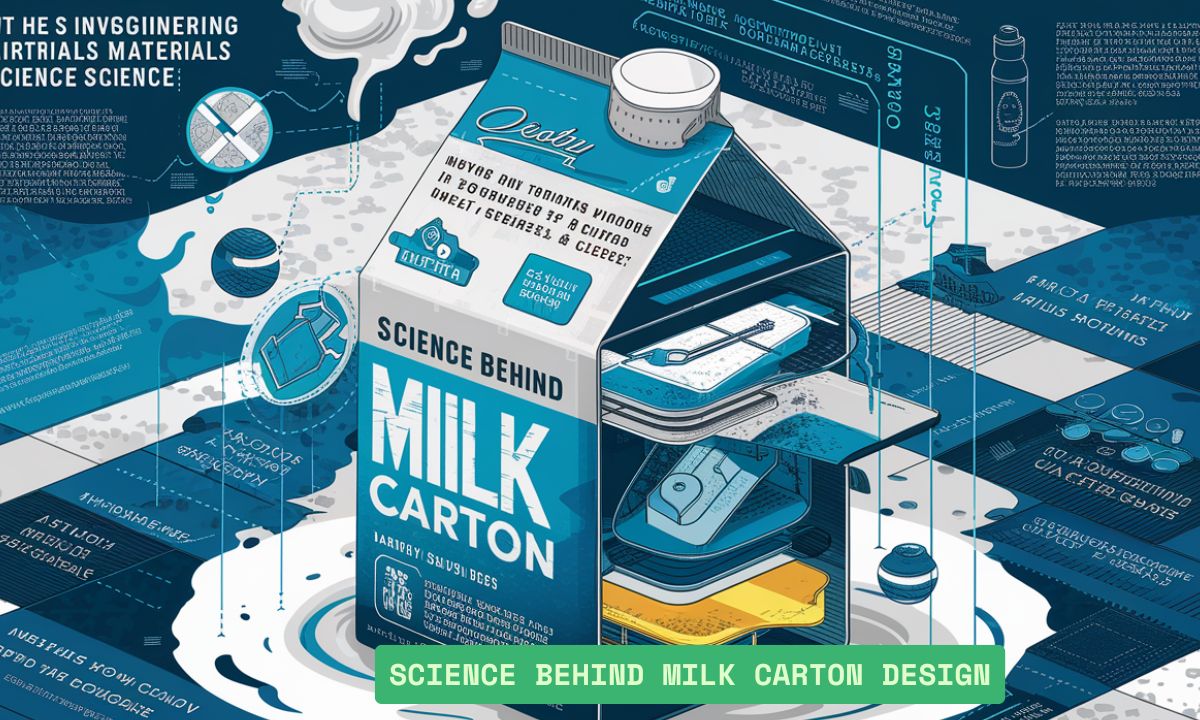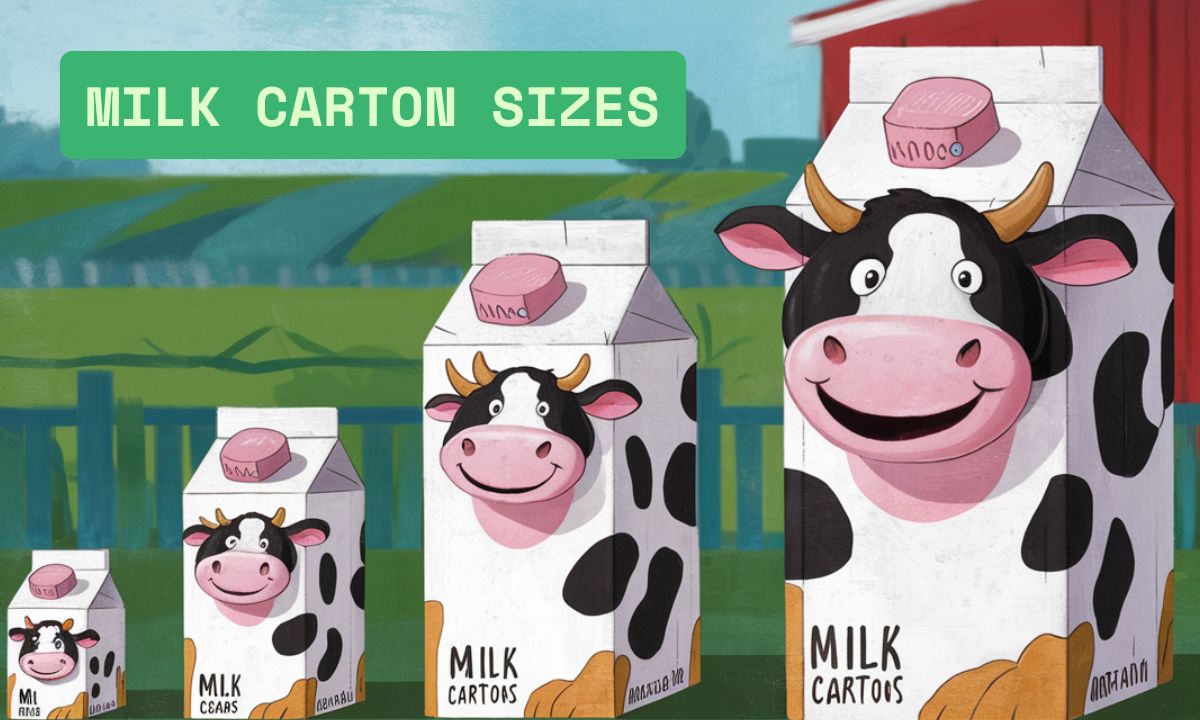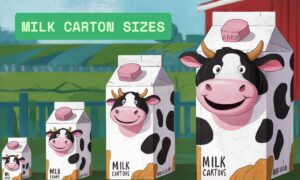Choosing the right milk carton size container impacts your grocery budget, food waste, and storage efficiency. Today’s dairy packaging systems offer multiple options tailored to diverse household consumption habits and refrigerator space constraints.
How Big Are Standard Milk Cartons?
Standard dairy containers span from compact 8-ounce individual servings to substantial 128-ounce family-sized jugs. Popular household options feature quart, half-gallon, and gallon formats that fill American refrigerators nationwide.
These uniform measurements emerged through careful planning rather than chance. Decades of industry research, consumer feedback, and storage logistics shaped each dimension. Every milk carton container size targets distinct market niches and usage scenarios.
Milk package dimensions receive precise engineering to optimize refrigerator compatibility while maximizing space utilization. Contemporary designs achieve balance between portability, product preservation, and manufacturing economics.
Summary
| Milk Container Type | Capacity (oz) | Capacity (ml) | Average Height | Ideal Usage |
| Individual School Pack | 8 oz | 236 ml | 3.75 inches | Kids’ meals, portion control |
| Pint Container | 16 oz | 473 ml | 5-6 inches | Specialty products, baking needs |
| Quart Package | 32 oz | 946 ml | 7-8 inches | Small families, cooking projects |
| Half-Gallon Unit | 64 oz | 1.89 L | 9-10 inches | Regular household consumption |
| Gallon Jug | 128 oz | 3.78 L | 10-12 inches | Large families, commercial use |
The Evolution of Milk Packaging
Dairy milk carton container development traces centuries of innovation, progressing from basic metal vessels to today’s advanced packaging systems. This transformation mirrors evolving consumer demands, technological breakthroughs, and urbanization trends that revolutionized dairy product distribution and storage methods.
From Glass Bottles to Paper Cartons
Historical milk transport relied on metal containers and glass vessels. Consumers carried personal receptacles for dairy purchases, functioning adequately when most families resided close to local farms.
Urban expansion demanded improved solutions. Glass containers controlled milk distribution through comprehensive home delivery systems. Professional milk deliverers formed crucial food supply networks throughout early 1900s communities.
Paper container adoption started during the 1930s following John Van Wormer’s “Pure-Pak” patent. This breakthrough enabled simultaneous container formation, sterilization, filling, and sealing at processing facilities, substantially minimizing contamination while reducing transportation expenses versus bulky glass alternatives.
Contemporary milk packaging maintains this innovative foundation. While materials and manufacturing have advanced significantly, core principles of lightweight construction and contamination protection persist unchanged.
More info kindly visit site:MarryGeneral.com
Common Milk Carton Sizes and Their Uses
Dairy milk carton container varieties range from compact 8-ounce individual portions to large 128-ounce bulk containers, with each format engineered for particular consumer requirements and usage patterns. Recognizing these size differences enables optimal selection matching your household’s specific consumption needs and budget considerations.
School Milk Cartons (8 oz / 236 ml)
Individual school containers contain precisely 8 ounces (236 milliliters) of dairy product. These compact rectangular packages measure approximately 3.75 inches in height with 2.25-inch square bases.
The recognizable peaked-roof configuration featuring distinctive triangular tops creates instant identification. These containers specifically address children’s nutritional requirements and portion management in educational institutions.
These miniature packages function as learning aids, with numerous school systems incorporating educational content, brain teasers, or nutritional data directly onto container surfaces. This approach converts routine dairy consumption into educational experiences for students.
Pint Cartons (16 oz / 473 ml)
Pint-capacity containers accommodate 16 ounces (473 milliliters) while typically measuring 5-6 inches tall. They excel for compact households, precise recipe measurements, or specialized dairy items including heavy cream and cultured buttermilk.
Professional bakers favor pint containers since numerous recipes specify exactly this quantity. Coffee establishments regularly utilize pint containers for operational efficiency, enabling quick pitcher refills without accessing larger containers that might deteriorate before complete usage.
The pint capacity achieves optimal balance in dairy distribution – sufficient volume for economic viability while maintaining manageable size ensuring product freshness for individuals or couples with moderate milk consumption.
Quart Cartons (32 oz / 946 ml)
Quart-sized containers hold 32 ounces (946 milliliters) while typically standing 7-8 inches tall with 4-inch square foundations. This intermediate option connects individual servings with bulk family purchases.
Quart popularity grew during post-war decades when home refrigeration became standard household equipment. Container dimensions received specific engineering to accommodate refrigerator door compartments efficiently – a design factor continuing to influence dairy packaging development.
Quart containers suit small families perfectly, occasional dairy consumers, or specialty products like flavored milk or lactose-reduced varieties requiring slower consumption than regular dairy products.
Half-Gallon Cartons (64 oz / 1.89 L)
Half-gallon containers accommodate 64 ounces (1.89 liters) representing among the most frequently purchased sizes by American households. These packages typically measure 9-10 inches tall becoming standard dairy merchandising units.
Half-gallon capacity achieves excellent equilibrium between cost-effectiveness and practicality. Sufficient volume provides family economy without excessive size causing spoilage before consumption. Container dimensions accommodate most refrigerator door storage perfectly.
While traditional paperboard containers maintain dominance in this category, handled plastic jugs have captured substantial market portions, particularly in areas where consumers travel extended distances between stores and homes.
Gallon Containers (128 oz / 3.78 L)
Gallon-capacity jugs contain 128 ounces (3.78 liters) providing the most cost-effective purchasing option for large households or institutional buyers. These substantial containers typically measure 10-12 inches tall requiring significant refrigerator accommodation.
Although paperboard containers once dominated this size, plastic gallon jugs became industry standard due to enhanced durability, reduced weight, and integrated handles facilitating easier pouring. Average gallon milk weighs approximately 8.6 pounds when completely filled.
Gallon containers significantly reduce packaging-to-product ratios, creating environmental efficiency regarding materials consumption per dairy ounce. However, this benefit only applies when complete contents get consumed before spoilage occurs.
Regional and International Variations
Dairy packaging varies considerably worldwide, reflecting different measurement standards, cultural preferences, and refrigeration technologies. These regional distinctions demonstrate innovative packaging approaches addressing local consumer requirements and storage constraints.
European Milk Packaging
European markets typically feature 1-liter (33.8 oz) or 2-liter (67.6 oz) containers, following metric system standards. These dimensions don’t exactly correspond with American measurements, creating minor recipe adjustments when cooking across international boundaries.
European dairy packaging frequently emphasizes different designs, with shelf-stable UHT products often utilizing aseptic brick-shaped containers requiring no refrigeration until opening. This packaging innovation reflects distinct shopping behaviors and compact refrigerators common in European homes.
Asian Milk Packaging Innovations
Japanese and other Asian markets frequently utilize distinctive plastic pouches or specialized bottles designed for compact refrigerators and households. Individual serving sizes predominate in regions where daily shopping occurs regularly and storage space remains limited.
South Korean manufacturers developed innovative banana-shaped containers preventing stacking, ensuring rapid consumption rather than forgotten storage in refrigerator backs – an intelligent design addressing waste reduction concerns.
The Science Behind Milk Carton Design

Contemporary dairy container engineering integrates materials science, ergonomic principles, and environmental factors creating optimal packaging solutions. Every design component serves multiple functions, from maintaining product freshness to ensuring user convenience while minimizing ecological impact.
Materials Science
Modern dairy containers represent decades of engineering advancement focusing on preservation, transportation efficiency, and consumer convenience. Every element serves specific functions, from microscopic polyethylene coatings preventing leakage to precisely calculated fold angles.
Contemporary typical containers feature multiple paperboard layers with food-grade polyethylene coating. This combination delivers structural integrity while establishing oxygen and light barriers preserving dairy freshness.
Ultra-pasteurized products requiring extended shelf life may incorporate sophisticated packaging including aluminum foil layers providing complete light and oxygen barriers, extending unrefrigerated storage from days to months.
Ergonomics and User Experience
Ridged edges along plastic jug tops aren’t merely decorative – they provide structural reinforcement while creating controlled pouring streams. Similarly, traditional container “roof” shapes establish natural spouts when properly opened.
These design features emerged through extensive consumer testing and improvement. Early containers proved notoriously difficult opening evenly, leading to specialized mechanisms including perforated tabs and plastic caps.
Environmental Considerations
Dairy packaging creates significant environmental consequences, with different sizes and materials presenting various sustainability challenges and benefits. Traditional paperboard containers offer substantial recyclability containing renewable materials.
Environmental calculations become complex considering transportation efficiency against food waste. Larger containers generally provide superior product-to-packaging ratios, though smaller containers may reduce discarded dairy due to spoilage.
Practical Applications of Understanding Milk Carton Sizes
Recognizing standard dairy volumes can substantially enhance kitchen efficiency, storage organization, and grocery budgeting. These practical applications enable smarter purchasing decisions and household food waste reduction.
Kitchen Conversion Tips
Understanding standard dairy container volumes simplifies cooking and baking processes:
- Individual school containers (8 oz) equal exactly 1 cup for recipes
- Quart packages hold precisely 4 cups
- Half-gallon units provide 8 cups – adequate for most family recipes
- These standardized measurements create useful reference points for cooking
Storage Optimization
Different container designs utilize refrigerator space uniquely. Rectangular containers maximize shelf efficiency but may challenge pouring when nearly empty. Circular plastic jugs pour easier but create wasted space between containers.
Optimal refrigerator organization accommodates quart and half-gallon containers perfectly on door shelves. Gallon jugs typically require main compartment storage. Consider transferring dairy to smaller containers as consumption progresses to reclaim storage space.
Budget Considerations
Larger containers almost always provide superior cost per ounce, though this economy only matters when consuming all dairy before spoilage. Households with variable consumption benefit from combining larger containers for regular use with smaller ultra-pasteurized backup containers providing both economy and convenience.
Where Did Milk Cartons Come From?
Dairy container origins trace to industrialization and urbanization requirements of early 20th century America. Before modern packaging, dairy distribution confronted significant challenges including spoilage, contamination, and transportation difficulties.
The Birth of the Milk Carton
Revolutionary packaging innovation commenced with John Van Wormer’s transformative patent revolutionizing dairy distribution permanently. His design concepts continue influencing contemporary container manufacturing processes utilized globally today.
The peaked-top design achieved iconic status providing structural strength while enabling easy manufacture from flat paperboard materials. This innovation established foundations for modern container manufacturing processes continuing today.
Alternative Milk Container Types and Sizes
Beyond traditional paperboard containers, diverse packaging alternatives provide unique advantages for varying consumer preferences and market segments. These options include proven glass bottles, convenient plastic jugs, and innovative pouches serving specific regional markets.
Glass Bottles
Glass containers maintain popularity in premium markets and home delivery services. Standard sizes include 16 oz, 32 oz, and 64 oz bottles. While heavier and costlier, glass provides superior taste preservation and environmental advantages through reusability.
Plastic Jugs
Plastic containers dominate gallon markets due to lightweight design and integrated handles. Manufacturing utilizes high-density polyethylene (HDPE) creating highly recyclable products, though actual recycling rates remain disappointingly low across many regions.
Milk Bags
Flexible pouches gain popularity in Canadian and international markets. These adaptable packages reduce packaging waste and storage requirements but necessitate special dispensers for home usage.
Future Trends in Milk Packaging
Emerging technologies and sustainability concerns drive revolutionary changes in dairy packaging design and materials. These innovations emphasize smart packaging features, environmental responsibility, and enhanced consumer convenience for modern marketplaces.
Concentrated dairy products reduce shipping weight and packaging requirements. Plant-based materials from agricultural waste or fungus-based compounds offer sustainable alternatives to traditional materials. Smart packaging incorporating QR codes connects consumers with source farms and production data.
Frequently Asked Questions
What’s the most popular milk container size?
Half-gallon (64 oz) packages remain the preferred choice for American families, achieving balance between economy and practical consumption rates.
How does container size affect milk freshness?
Smaller packages typically maintain freshness longer after opening due to reduced air exposure, while larger containers may deteriorate faster once opened.
Which material works better – paper or plastic containers?
Paperboard containers offer superior environmental friendliness and light protection, while plastic jugs provide durability and convenience for larger sizes.
Why do school containers have triangular tops?
The peaked-top design provides structural strength while enabling easy manufacture from flat materials, with the triangular roof creating natural pouring spouts.
What’s the smallest available container size?
Individual serving packages of 4-6 oz exist in some markets, though 8 oz school containers represent the most common small size option.
Conclusion
Understanding dairy container sizing enables informed purchasing decisions matching your household’s consumption patterns. From compact 8-ounce individual servings to substantial gallon containers, each size addresses specific requirements and market segments.
Dairy packaging evolution reflects broader societal, technological, and consumer behavior changes. Modern containers represent sophisticated engineering balancing freshness preservation, transportation efficiency, and environmental considerations.
Selecting appropriate sizes for your needs reduces food waste, saves money, and optimizes refrigerator storage while ensuring your family maintains fresh dairy availability.












